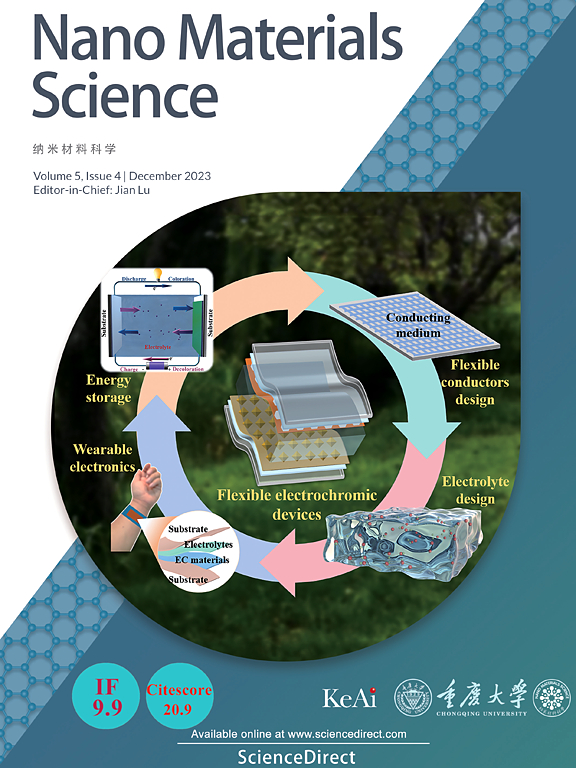Co2.5Ni0.5Si2O5(OH)4纳米阵列在还原氧化石墨烯上原位受限垂直生长,实现高效析氧反应
IF 9.9
2区 材料科学
Q1 Engineering
引用次数: 0
摘要
合理设计低成本的析氧反应(OER)催化剂将大大提高经济效益。利用地球上丰富的元素Si, Co和Ni,我们生产了一种独特的结构,将钴镍硅酸盐氢氧化物[Co2.5Ni0.5Si2O5(OH)4]垂直生长在还原氧化石墨烯(rGO)载体上(CNS@rGO)。这是一种低成本、有前景的OER催化剂。与钴或硅酸镍hydroxide@rGO(分别为CS@rGO和NS@rGO)纳米阵列相比,双金属CNS@rGO纳米阵列表现出令人印象深刻的OER性能,过电位为307 mV@10 mA cm−2。该值高于CS@rGO和NS@rGO。CNS@rGO纳米阵列的过电位为446 mV@100 mA cm−2,约为商用RuO2电催化剂的1.4倍。所获得的OER活性优于最先进的金属氧化物/氢氧化物及其衍生物。垂直生长的纳米结构和优化的金属-支撑电子相互作用对OER性能的提高起着不可或缺的作用,包括快速的电子转移途径、更短的质子/电子扩散距离、更活跃的金属中心以及优化的双原子电子密度。利用层间化学调控和原位生长的方法,先进结构的CNS@rGO纳米阵列为合理、灵活地设计高效、有前途的OER电催化剂提供了新的视野。本文章由计算机程序翻译,如有差异,请以英文原文为准。
In situ confined vertical growth of Co2.5Ni0.5Si2O5(OH)4 nanoarrays on rGO for an efficient oxygen evolution reaction
Rational design of oxygen evolution reaction (OER) catalysts at low cost would greatly benefit the economy. Taking advantage of earth-abundant elements Si, Co and Ni, we produce a unique-structure where cobalt-nickel silicate hydroxide [Co2.5Ni0.5Si2O5(OH)4] is vertically grown on a reduced graphene oxide (rGO) support (CNS@rGO). This is developed as a low-cost and prospective OER catalyst. Compared to cobalt or nickel silicate hydroxide@rGO (CS@rGO and NS@rGO, respectively) nanoarrays, the bimetal CNS@rGO nanoarray exhibits impressive OER performance with an overpotential of 307 mV@10 mA cm−2. This value is higher than that of CS@rGO and NS@rGO. The CNS@rGO nanoarray has an overpotential of 446 mV@100 mA cm−2, about 1.4 times that of the commercial RuO2 electrocatalyst. The achieved OER activity is superior to the state-of-the-art metal oxides/hydroxides and their derivatives. The vertically grown nanostructure and optimized metal-support electronic interactions play an indispensable role for OER performance improvement, including a fast electron transfer pathway, short proton/electron diffusion distance, more active metal centers, as well as optimized dual-atomic electron density. Taking advantage of interlay chemical regulation and the in-situ growth method, the advanced-structural CNS@rGO nanoarrays provide a new horizon to the rational and flexible design of efficient and promising OER electrocatalysts.
求助全文
通过发布文献求助,成功后即可免费获取论文全文。
去求助
来源期刊

Nano Materials Science
Engineering-Mechanics of Materials
CiteScore
20.90
自引率
3.00%
发文量
294
审稿时长
9 weeks
期刊介绍:
Nano Materials Science (NMS) is an international and interdisciplinary, open access, scholarly journal. NMS publishes peer-reviewed original articles and reviews on nanoscale material science and nanometer devices, with topics encompassing preparation and processing; high-throughput characterization; material performance evaluation and application of material characteristics such as the microstructure and properties of one-dimensional, two-dimensional, and three-dimensional nanostructured and nanofunctional materials; design, preparation, and processing techniques; and performance evaluation technology and nanometer device applications.
 求助内容:
求助内容: 应助结果提醒方式:
应助结果提醒方式:


